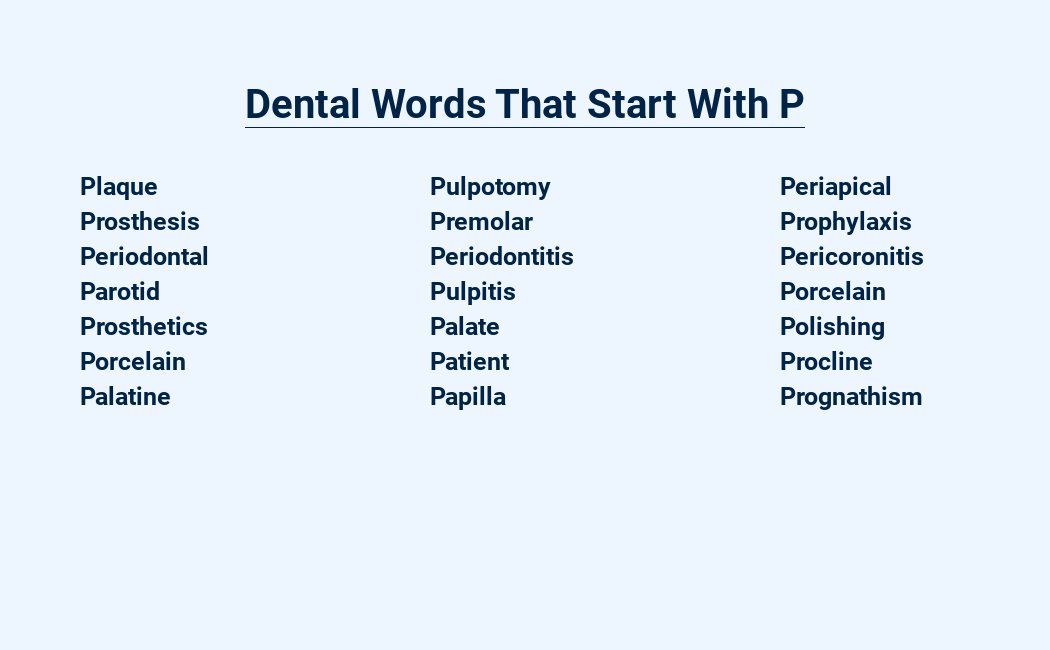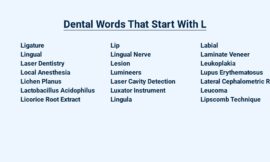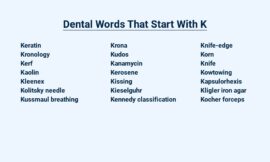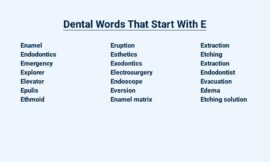Embark on a journey of dental enlightenment as we dive into the world of dental words beginning with P.
From the buildup of plaque to the strength of porcelain crowns, from the core of the tooth (pulp) to the intricate network of periodontal disease, discover the fascinating facets of oral health.
Explore pedodontics, the art of caring for children’s teeth, and delve into palatal expansion, a technique to widen the upper jaw.
| Term | Definition |
| Palatal | Relating to the roof of the mouth. |
| Papilla | A small, fleshy projection on the tongue or gums. |
| Parotid gland | One of the major salivary glands, located in front of the ear. |
| Partial denture | A removable dental appliance that replaces some, but not all, of the missing teeth. |
| Pedodontics | The branch of dentistry that deals with the care of children’s teeth. |
| Periapical abscess | An infection at the tip of the root of a tooth. |
| Periodontal disease | A group of diseases that affect the gums and the tissues supporting the teeth. |
| Permanent teeth | The second set of teeth that erupt in adulthood, replacing the baby teeth. |
| Plaque | A sticky film of bacteria that forms on the teeth. |
| Polishing | The process of smoothing and shining the surface of a tooth. |
| Pulp | The soft tissue inside the tooth that contains blood vessels, nerves, and connective tissue. |
| Pulpitis | An inflammation of the pulp. |
Palatal Lift: A dental procedure that involves raising the soft palate to reduce snoring and obstructive sleep apnea.
Palate: The roof of the mouth, which separates the oral cavity from the nasal cavity.
Panoramic Radiograph: A dental X-ray that provides a wide-angle view of the entire mouth, including the teeth, jaws, and surrounding structures.
Papilla: A small, fleshy projection on the surface of the tongue or gums.
Paranasal Sinuses: Air-filled cavities located within the bones surrounding the nose. Dental infections can sometimes spread to these sinuses, causing sinusitis.
Partial Denture: A removable dental prosthesis that replaces some missing teeth, but not all of them.
Patient Education: The process of providing information and instructions to patients about their oral health and dental treatments.
Pedodontics: The branch of dentistry that focuses on the oral health of children and adolescents.
Penicillin: An antibiotic medication used to treat bacterial infections in dentistry, such as gum disease and abscessed teeth.
Periapical Radiograph: A dental X-ray that shows the entire tooth, including the root and surrounding bone.
Periodontal Charting: The process of measuring and recording the depth of periodontal pockets around the teeth.
Periodontal Disease: A chronic inflammatory disease that affects the gums and supporting structures of the teeth.
Periodontic Surgery: Surgical procedures performed to treat periodontal disease, such as gum grafting and pocket reduction surgery.
Periodontics: The branch of dentistry that focuses on the prevention, diagnosis, and treatment of periodontal disease.
Periradicular Surgery: A surgical procedure to remove infected tissue from around the root of a tooth.
Permanent Tooth: A tooth that replaces a baby tooth and is intended to last a lifetime.
Pit and Fissure Sealant: A thin, plastic coating applied to the chewing surfaces of teeth to prevent cavities.
Plaque: A sticky film of bacteria that forms on the teeth and can cause cavities and gum disease.
Polishing: The process of smoothing the surface of a tooth after a filling or other dental procedure.
Polycarbonate Crown: A type of temporary dental crown made from a plastic material.
Porcelain Crown: A type of dental crown made from porcelain, which is a strong and эстетически appealing material.
Porcelain Veneer: A thin layer of porcelain that is bonded to the front surface of a tooth to improve its appearance.
Post and Core: A dental procedure used to restore a tooth that has lost a significant amount of structure.
Premedication: The administration of medication before a dental procedure to reduce anxiety or pain.
Preventive Dentistry: The practice of preventing oral diseases, such as cavities and gum disease, through regular checkups, cleanings, and fluoride treatments.
Primary Tooth: A baby tooth that is eventually replaced by a permanent tooth.
Prophylaxis: A dental cleaning that involves removing plaque and tartar from the teeth.
Prosthodontics: The branch of dentistry that focuses on the restoration and replacement of missing teeth.
Pulp: The soft tissue inside the tooth that contains nerves and blood vessels.
Pulp Canal: The space inside the tooth that contains the pulp.
Pulp Cap: A dental procedure that involves placing a protective material over the exposed pulp of a tooth to prevent infection.
Pulpitis: Inflammation of the pulp, which can be caused by deep cavities or trauma to the tooth.
Pulpotomy: A dental procedure that involves removing the inflamed portion of the pulp from a tooth.
Pediatric Dentistry: The branch of dentistry that focuses on the oral health of children and adolescents.
Pediatric Dentist: A dentist who specializes in the care of children’s teeth.
Patient: A person who receives dental care from a dentist.
Pathology: The study of the causes and effects of disease.
Periapical Lesion: An area of bone destruction around the root of a tooth, caused by infection.
Pericoronitis: Inflammation of the gum tissue surrounding an erupting tooth, often a wisdom tooth.
Periodontal Abscess: A collection of pus in the periodontal tissues, caused by bacterial infection.
Periodontal Ligament: A group of fibers that connect the tooth to the bone.
Periodontal Pocket: A space between the tooth and the gum tissue, created by the destruction of the periodontal ligament.
Periodontal Probe: An instrument used to measure the depth of periodontal pockets.
Periodontal Scaling and Root Planing: A dental procedure that involves removing plaque, tartar, and diseased tissue from the teeth and root surfaces.
Periodontist: A dentist who specializes in the diagnosis and treatment of periodontal disease.
Permanent Teeth: The second set of teeth that erupt in the mouth, replacing the baby teeth.
Pit and Fissure: A depression or groove on the chewing surface of a tooth.
Plaque: A sticky film of bacteria that forms on the teeth and can cause cavities and gum disease.
Porcelain Crown: A type of dental crown made from porcelain, a strong and эстетически appealing material.
Porcelain Veneer: A thin layer of porcelain that is bonded to the front surface of a tooth to improve its appearance.
Post and Core: A dental procedure used to restore a tooth that has lost a significant amount of structure.
Premedication: The administration of medication before a dental procedure to reduce anxiety or pain.
Preventive Dentistry: The practice of preventing oral diseases, such as cavities and gum disease, through regular checkups, cleanings, and fluoride treatments.
Primary Tooth: A baby tooth that is eventually replaced by a permanent tooth.
Prognosis: The predicted outcome of a dental condition or treatment.
Prosthodontics: The branch of dentistry that focuses on the restoration and replacement of missing teeth.
Proximal Surface: The surface of a tooth that faces another tooth.
Pulp: The soft tissue inside the tooth that contains nerves and blood vessels.
Pulp Canal: The space inside the tooth that contains the pulp.
Pulp Cap: A dental procedure that involves placing a protective material over the exposed pulp of a tooth to prevent infection.
Pulpitis: Inflammation of the pulp, which can be caused by deep cavities or trauma to the tooth.
Pulpotomy: A dental procedure that involves removing the inflamed portion of the pulp from a tooth.
Puncture Wound: A wound caused by a sharp object piercing the skin or tissue.
Pus: A thick, yellowish fluid that is produced by the body in response to infection.
Pyorrhea: An outdated term for periodontal disease.
Dental Words Beginning with P
Plaque
Plaque is a sticky film of bacteria that forms on teeth.
It is the primary cause of cavities and gum disease.
Plaque can be removed by brushing and flossing regularly.
Porcelain Crown
Porcelain crowns are tooth-shaped caps that cover the entire visible portion of a damaged tooth.
They are made of porcelain, a durable and aesthetically pleasing material that closely resembles the color and translucency of natural teeth.
Porcelain crowns are used to restore the strength, appearance, and functionality of damaged teeth.
Pulp
Pulp, the soft tissue inside a tooth, contains nerves, blood vessels, and connective tissue.
It’s responsible for tooth sensation and nourishment.
Pulp can become inflamed or infected, leading to pain and sensitivity.
Root canal treatment involves removing the pulp from a tooth to alleviate pain and prevent further infection.
Periodontal Disease
Periodontal disease, also known as gum disease, is a bacterial infection of the gums and the tissues that support the teeth. It can cause inflammation, bleeding, and gum recession, and if left untreated, can lead to tooth loss.
Regular dental checkups and cleanings can help prevent and treat periodontal disease.
Pedodontics
Pedodontics, also known as pediatric dentistry, focuses on the oral health of children from infancy through adolescence. It encompasses preventive care, restorative treatments, and management of dental conditions unique to this age group.
Pedodontists are specially trained to address the unique needs of young patients.
Palatal Expension
Palatal expansion is a dental procedure that widens the upper jaw to create more space for teeth. This can be done with a variety of appliances, such as expanders and plates.
Palatal expansion is often used to correct overcrowding, crossbites, and other orthodontic problems.
Prosthodontics
Prosthodontics, a branch of dentistry, focuses on restoring and replacing missing or damaged teeth and oral structures to improve function, aesthetics, and overall oral health.
It encompasses various treatments, including crowns, bridges, dentures, implants, and maxillofacial prosthetics, aiming to restore a patient’s ability to speak, chew, and smile confidently.
Periodontist
Periodontist: A dental specialist focused on the prevention, diagnosis, and treatment of periodontal disease, which affects the gums and tissues surrounding the teeth. They are experts in maintaining oral health and restoring gum tissues to a healthy state.
Pit and Fissure Sealant
Pit and Fissure Sealant: A protective coating applied to the chewing surfaces of molars and premolars to prevent cavities.
The sealant fills in the grooves and pits where food and bacteria can collect, reducing the risk of decay.
Permanent Tooth
Permanent teeth are the adult teeth that replace baby teeth.
They are stronger and larger than baby teeth and are designed to last a lifetime.
Permanent teeth typically start to erupt around the age of 6 and are all in place by the early twenties.
Final Verdict
Understanding dental words that start with P, such as plaque, porcelain crown, pulp, periodontal disease, pedodontics, palatal expansion, prosthodontics, periodontist, pit and fissure sealant, and permanent tooth, is crucial for maintaining good oral health.
Regular dental checkups, proper brushing and flossing techniques, and a balanced diet are essential in preventing and treating dental issues.
Consulting with a qualified dentist or dental professional is highly recommended for any dental concerns or questions.




